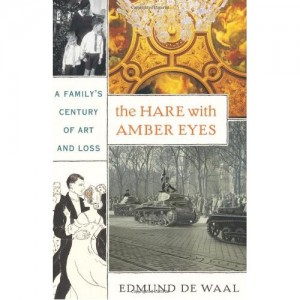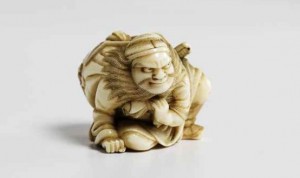When a well-known curator and artist inherits a collection of 150 netsuke–button-sized Japanese carvings in ivory or wood–he starts to think about how it came into his hands. Netsuke are button-sized Japanese carvings in ivory or wood that according to Wikipedia have a functional use–to hold up purses of men in kimonos, which otherwise have no pockets.

The inquiry becomes a quirky family history about power, wealth, inheritance and obsession. The Hare with Amber Eyes is by Edmund de Waal, former curator of ceramics at the Victoria & Albert Museum and a ceramics installation artist in his own right.

He traces a family fortune back to a Jewish grain merchant in Odessa who parlays his success into international banking. The story focuses first on Charles Ephrussi, whose family branch was dispatched to Paris to help run the family bank there. Charles becomes a well-known aesthete, a connoisseur and art critic in the 1900s, who purchases the netsuke for his personal collection.
(That collection includes Monets, Manets, Degas and more. Charles is pictured in Renoir’s Luncheon of the Boating Party–the gentleman in the top-hat, facing away. )

Charles eventually gives away his netsuke collection, some of which you can see on de Waal’s web site. The collection moves to Vienna, gifted to an Ephrussi nephew and wife upon their marriage.
In the course of the story, we learn how the wealthy Jewish families of Paris lived, and then how the wealthy Jews of Vienna lived, until under the Nazis the Viennese Ephrussis lose their livelihoods, their fortunes and their homeland. The netsuke however remain within the family, in the care of de Waal’s great uncle, who builds a life for himself in post-World War II Japan.
The integration of social and personal history make this book so much more than a mere family history. It is a tale of migrations and turmoil, told with astonishing detail and intelligence, largely through the language of possessions and objects. The tie-in of the author’s own interests in Japan and its art and ceramics adds another layer of interest to the storytelling.
I was riveted and I was charmed.
Info about a new, illustrated version (U.K.), The Hare with Amber Eyes: A Hidden Inheritance, is on de Waal’s website.
I read the original version, The Hare with Amber Eyes: A Family’s Century of Art and Loss, which includes some wonderful photographs of the family.
Hardcover: 368 pages
Publisher: Farrar, Straus and Giroux (August 31, 2010)
Language: English
ISBN-10: 0374105979
ISBN-13: 978-0374105976





